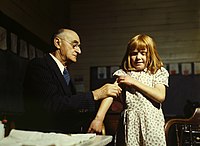Immunization


Immunization, or immunisation, is the process by which an individual's immune system becomes fortified against an agent (known as the immunogen).
When an immune system is exposed to molecules that are foreign to the body (non-self), it will orchestrate an immune response, but it can also develop the ability to quickly respond to a subsequent encounter (through immunological memory). This is a function of the adaptive immune system. Therefore, by exposing an animal to an immunogen in a controlled way, its body can learn to protect itself: this is called active immunization.
The most important elements of the immune system that are improved by immunization are the B cells (and the antibodies they produce) and T cells. Memory B cell and memory T cells are responsible for a swift response to a second encounter with a foreign molecule. Passive immunization is when these elements are introduced directly into the body, instead of when the body itself has to make these elements.
Immunization can be done through various techniques, most commonly vaccination. Vaccines against microorganisms that cause diseases can prepare the body's immune system, thus helping to fight or prevent an infection. The fact that mutations can cause cancer cells to produce proteins or other molecules that are unknown to the body forms the theoretical basis for therapeutic cancer vaccines. Other molecules can be used for immunization as well, for example in experimental vaccines against nicotine (NicVAX) or the hormone ghrelin (in experiments to create an obesity vaccine).
Passive and active immunization
Immunization can be achieved in an active or passive fashion: vaccination is an active form of immunization.
Active immunization
Active immunization entails the introduction of a foreign molecule into the body, which causes the body itself to generate immunity against the target. This immunity comes from the T cells and the B cells with their antibodies.
Active immunization can occur naturally when a person comes in contact with, for example, a microbe. If the person has not yet come into contact with the microbe and has no pre-made antibodies for defense (like in passive immunization), the person becomes immunized. The immune system will eventually create antibodies and other defenses against the microbe. The next time, the immune response against this microbe can be very efficient; this is the case in many of the childhood infections that a person only contracts once, but then is immune.
Artificial active immunization is where the microbe, or parts of it, are injected into the person before they are able to take it in naturally. If whole microbes are used, they are pre-treated, Attenuated vaccine. Depending on the type of disease, this technique also works with dead microbes, parts of the microbe, or treated toxins from the microbe.
Passive immunization
Passive immunization is where pre-synthesized elements of the immune system are transferred to a person so that the body does not need to produce these elements itself. Currently, antibodies can be used for passive immunization. This method of immunization begins to work very quickly, but it is short lasting, because the antibodies are naturally broken down, and if there are no B cells to produce more antibodies, they will disappear.
Passive immunization occurs physiologically, when antibodies are transferred from mother to fetus during pregnancy, to protect the fetus before and shortly after birth.
Artificial passive immunization is normally administered by injection and is used if there has been a recent outbreak of a particular disease or as an emergency treatment for toxicity (for example, for tetanus). The antibodies can be produced in animals ("serum therapy") although there is a high chance of anaphylactic shock because of immunity against animal serum itself. Thus, humanized antibodies produced in vitro by cell culture are used instead if available.
